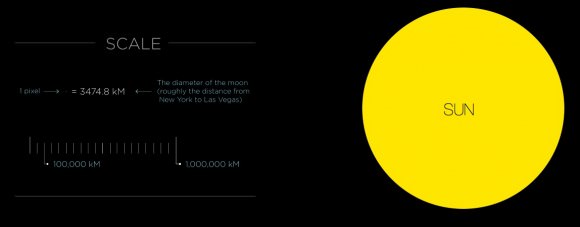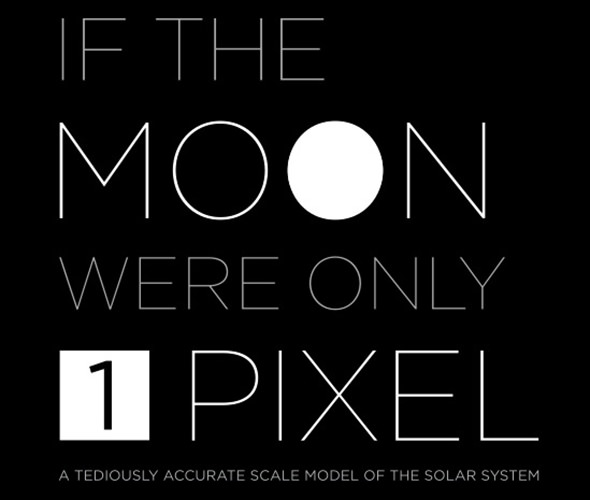One of my favorite pet peeves is the inability of conventional models to accurately convey the gigantic scale of the Solar System. Most of us grew up with models of the planets made of wood or plastic or spray painted styrofoam balls impaled on bent wire hangers (don’t tell Mommy), or, more commonly, illustrations on posters and in textbooks. While these can be fun to look at and even show the correct relative sizes of the planets (although usually not as compared to the Sun) there’s one thing that they simply cannot relate to the viewer: space is really, really, really big.
Now there are some more human-scale models out there that do show how far the planets are from each other, but many of them require some walking, driving, or even flying to traverse their full distances. Alternatively, thanks to the magic of web pages which can be any size you like limited only by the imagination of the creator (and the patience of the viewer), accurate models can be easily presented showing the average (read: mind-blowingly enormous) distances between the planets… and no traveling or wire hangers required.
This is one of those models.* Enjoy.

Created by designer Josh Worth, “If the Moon Were Only 1 Pixel: A Tediously Accurate Scale Model of the Solar System” uses a horizontally-sliding HTML page to show how far it is from one planet to another, as well as their relative sizes, based on our Moon being just a single pixel in diameter (and everything lined up neatly in a row, which it never is.) You can use the scroll bar at the bottom of the page or arrow keys to travel the distances or, if you want to feel like you’re at least getting some exercise, scroll with your mouse or computer’s swipe pad (where applicable.) You can also use the astronomical symbols at the top of the page to “warp” to each planet.
Just try not to miss anything — it’s a surprisingly big place out there.
“You may think it’s a long way down the road to the chemist’s, but that’s just peanuts to space.”
– Douglas Adams
See more of Josh Worth’s work here. (HT to Alan Stern.)
*And this is another one.


A tedious page if there ever was one. When will people who produce these things learn that the web is meant to scroll vertically instead of horizontally?
Everyone’s a critic. 😉
@dangerdad; are you kidding me? If you don’t get this space map, then, I’d safely say this article is far beyond your mental capacity. The planets do not orbit the Sun in a vertical order, they orbit it at its equator. Why would the author have you scroll vertically, when the planets do not orbit in such an order? Find another topic, apparently, Astronomy is not within your IQ. Also, its not tedious…. its meant to be this way, in an attempt to give the reader as close an experience in the exact distances of the space between the planets of our Solar System. You definitely, do not understand this topic.
@jetgeorge
Technically speaking it wouldn’t matter, as it would just be from a top-down view point.
Also Dangerdad said nothing about not understanding the subject, he was simply questioning the execution of the layout. (It WOULD be much more handy as vertical layout from a practical standpoint.)
Even though conveying the feeling of immensity sounds fun, it normally lies within the same plane as the sense of vertigo. It doesn’t have meaning even if it does touches the sense.
So if you ever want to have a feeling of how large our universe is, get to that point where the vertigo starts. (Some vids on YouTube are probably better suited than real life, like that climb up the RadioTower due to the swaying of the camera.)
And than know, you didn’t even leave Earth yet. There is still the Moon, Sun, Jupiter before you’ve even left our Solar System. … our Galaxy, Virgo Cluster and the rest.
A reminder of just how vast out solar system truly is!
Now run NASA’s Eyes Visualization “Eyes on exoplanets” and get a feel
for the size of the milkyway.
Where is Triton? It is bigger than Pluto. It should be there.
@thameron: Why? The author was not trying to make a point in relation to the moons. He probably included the moons of Jupiter and Saturn’s Titan due to their popularity among astronomers and the fact that they have been studied by spacecraft more closely than Triton. Why don’t you folks stick to the important points that the author is attempting to state and not your own personal agendas? Triton is of no importance in this topic.
You should put VY Canis Majoris behind the image